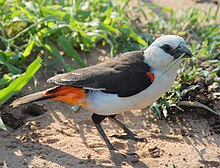White-headed buffalo weaver
| White-headed buffalo weaver | |
|---|---|

| |
| D. d. boehmi Serengeti National Park, Tanzania | |
| Scientific classification | |
| Domain: | Eukaryota |
| Kingdom: | Animalia |
| Phylum: | Chordata |
| Class: | Aves |
| Order: | Passeriformes |
| Family: | Ploceidae |
| Genus: | Dinemellia Reichenbach, 1863 |
| Species: | D. dinemelli
|
| Binomial name | |
| Dinemellia dinemelli (Rüppell, 1845)
| |
The white-headed buffalo weaver or white-faced buffalo-weaver (Dinemellia dinemelli) is a species of passerine bird in the family Ploceidae native to East Africa.[2] The buffalo part of its name derives from its habit of following the African buffalo, feeding on disturbed insects.[3] Two subspecies are recognized.
Taxonomy
The white-headed buffalo weaver was first described by the German naturalist Eduard Rüppell in 1845.[4]
Subspecies
Two subspecies of the white-headed buffalo weaver are now recognized.[4]
- D. d. dinemelli (E. Rüppell, 1845), northern part of its range: Sudan, Ethiopia, Somalia, Uganda, northern Kenya.
- D. d. boehmi (A. Reichenow, 1885), southern part of its range: Kenya and Tanzania.
Description
The white-headed buffalo weaver is 170 to 190 mm (6.7–7.5 in) in length and 57 to 85 g (2.0–3.0 oz) in weight.[3] In addition to its white head and underparts, the white-headed buffalo weaver has a vividly orange-red rump and undertail coverts.[5] Its thighs are dark brown. Narrow white bands can be found on the wings especially when stretch his wings sideways. Both sexes are similar in plumage and hard to differentiate. The bill is conical and black.[3] D. d. dinemelli has a brown tail, whereas D. d. boehmi has a black tail.[6]
Distribution and habitat
The white-headed buffalo weaver is native to the African countries of Ethiopia, Kenya, Somalia, Sudan, Tanzania, and Uganda.[4] It prefers habitats such as savanna, and shrublands, but especially dry brush and acacia thickets.[3][5][1]
Behaviour

Like most weavers, it is a
Breeding pairs are monogamous and nests are built together. The breeding season is related to rainfall and varies according to local conditions. Nest materials are pushed together, not interwoven, to form an oval 570 millimetres (22 in) wide. A short entrance tube opens downwards and is about 2 to 4 metres (6.6–13.1 ft) above the ground. Soft materials line the inner portions of the nest, which usually has several rooms, with defensive thorny branches on the outside.
References
- ^ a b BirdLife International (2012). "Dinemellia dinemelli". IUCN Red List of Threatened Species. 2012. Retrieved 26 November 2013.
- ^ "White-headed Buffalo Weaver Dinemellia dinemelli". BirdLife International. Retrieved 2 June 2011.
- ^ a b c d e f g "White-headed Buffalo Weaver Dinemellia dinemelli". Oiseaux-Birds. Retrieved 2 June 2011.
- ^ a b c "White-headed Buffalo Weaver (Dinemellia dinemelli)". Internet Bird Collection. Retrieved 2 June 2011.
- ^ a b c "White-headed Buffalo Weaver". Kenya Birds. Retrieved 2 June 2011.
- ^ a b "White-headed Buffalo Weaver". Los Angeles Zoo. Retrieved 2 June 2011.
- ^ a b "White-headed Buffalo Weaver". Honolulu Zoo. Retrieved 2 June 2011.
- ^ Saint Louis Zoological Park. Retrieved 2 June 2011.
External links
- White-headed buffalo-weaver - Species text in Weaver Watch.

